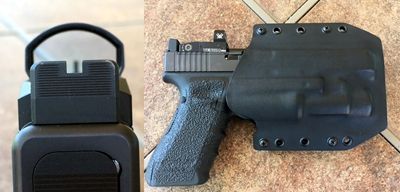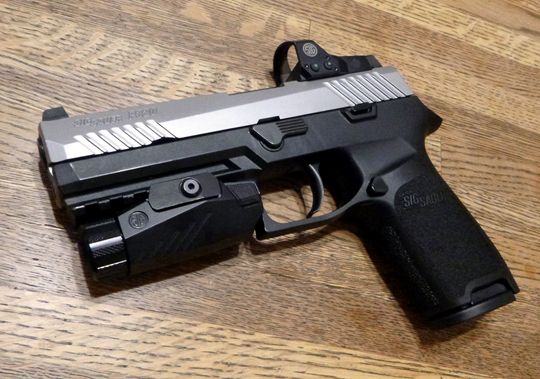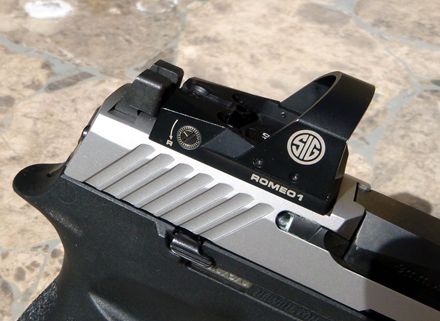Since 2009, Bill Whitecotton has hosted Mid-Week Evening Practical Pistol
matches for the club, twice a year. The idea is to compete and train for
defensive shooting situations in low- to no-light conditions. We begin
the matches in the late afternoon and continue until it becomes totally
dark. It’s been very humbling and frustrating to see how much my ability
to hit targets deteriorates after it becomes dark and I can no longer see
the sights.
I’ve tried a number of different things over the years – a headlight
strapped to my forehead; a tactical flashlight held in my weak hand; a
Crimson Trace laser grip which activates when you grip the gun. None of
these has ever proven to boost my pathetic scores in this match, and thus
I’ve always had this queasy, uneasy feeling that if a real life situation
should ever occur, that I was not prepared.
A couple of years back, I picked up a S&W M&P 40. This is the gun on
which I mounted the Crimson Trace laser grip. Not long after I purchased
that pistol, S&W came out with the M&P C.O.R.E., which stands for
Competition Optics Ready Equipment. These guns have their slides cut to
allow you to mount a miniature red dot sight. The pistol ships with a
number of adapter plates to allow you to mount your choice of a Trijicon
RMR, Leupold Delta Point, Jpoint, Doctor, C-More STS, or Insight MRDS.
I’ve been wanting to get one of these M&P C.O.R.E.s for a while. I finally
had a few extra bucks in my pocket, so I started looking around. Which
miniature red dot sight should I use? As always, total cost was an
important consideration.
Then I found the SIG Sauer P320RX. I knew nothing about the P320 until I
discovered the RX. I learned that the Army had chosen the P320 as their
next generation service pistol. Last month I wrote about that, and about
the SIG P320 FDE Compact that I purchased. That one was actually my second
SIG P320. I bought the Full Size P320RX first, specifically with the intent
to improve my standing in the upcoming Midweek Evening PP shoot.
So what is a P320RX? The RX designation means that the slide is cut, and
the pistol is equipped and sighted-in from the factory with SIG’s Romeo1
miniature red dot sight. Not only that, but the pistol is equipped with
taller “suppressor ready” iron night sights. In the dark, the three sight
alignment dots glow due to tritium inserts.
The taller sights allow the red dot to co-witness with the iron sights.
When the red dot is switched on, the dot appears right on top of the front
sight when the irons are aligned. This is a big advantage, as sometimes it
can be hard to find the red dot when you first bring the pistol up between
your eyes and the target. All you have to do is attempt to line up the iron
sights as you would with any pistol, and the red dot will magically appear
in your line of vision. Then you switch your focus to the red dot, align on
target, and squeeze through the striker trigger travel. Clang!
I’ve got to say that a red dot sight on a defensive pistol is a godsend to
these almost 60-year-old eyes (how did I get here?). It has become quite
difficult to use iron sights, especially in a fast-paced sport like Practical
Pistol.
The Romeo1 has a feature which turns off the dot automatically if there has
been no motion for 2 to 3 minutes. The SIG marketers call that MOTAC for
Motion Activated Illumination. Honestly, I never use this feature. If it’s
in your holster, the pistol is in constant motion, the dot never goes off.
If it’s in your nightstand next to your bed, the feature requires a trickle
current, which means that after some time, maybe a month, you won’t have
enough power to light the dot. That could be disastrous in an emergency.
I manually switch the dot on and off by holding one of the brightness
adjustment buttons (▼ ▲) on the side of the unit for more than
two seconds.
The RX is available in both the Full Size and Compact pistol sizes from SIG.
Mine is a Cabela’s exclusive in the silver and black two-tone. Cabela’s has
been offering these on sale for considerably less than the standard all-black
versions which are available elsewhere. These are selling for under $800.
That’s a smokin’ deal for what you get.
When I walked into Cabela’s, I had a bias toward getting the big one, but I
asked to handle both the Full Size and the Compact. The Compact felt fine,
it fit my hand well, but I walked out with the Full Size anyway.
It’s worth mentioning that while the Army M17s and M18s have slide cuts
specifically for the Leupold DeltaPoint Pro, as specified by the Army, the
P320RX has a different slide cut specifically for SIG’s Romeo1 MRDS. It
requires no adapter plate to mount the optic like an S&W M&P C.O.R.E. does.
Thus it mounts a tiny bit lower on the slide. The iron sights do not have
to be quite as tall as those on the C.O.R.E to co-witness with the red dot.

SIG Sauer Foxtrot1 pistol light
|
SIG was able to do this because they make their own MRDS. No other gun maker
that I know of has its own electro-optics division like SIG does.
In the last 10 years or so, SIG Sauer has been a gun company on the move.
There are actually two SIG Sauer companies. There is the Swiss-German SIG
Sauer GmbH, and there is the totally American SIG Sauer, Inc. SIG Sauer Inc.
used to be SIGARMS. It started as the American distributor for the
Swiss-German SIG Sauer guns. Over time, SIGARMS began to design and manufacture
firearms that would better suit the American market. In October of 2007, SIGARMS
changed its name to SIG Sauer, Inc. They now design and manufacture pistols,
carbines, rifles, air guns, ammunition, optics, suppressors, and more. SIG
Sauer, Inc. is now the largest in a group of companies that include J.P. Sauer
& Sohn, Blaser, and Swiss Arms. If you became concerned that the U.S. Army had
chosen a foreign pistol, your fears are unfounded, as the P320 is totally American
designed and manufactured by SIG Sauer, Inc. in Newington, New Hampshire.
Mike’s Gen 4 Glock 34 MOS

By Mike Sardinha
|
 I have been joking for the last couple of years that finding this club has put a severe
dent in my wallet. Case in point, is my Glock 34. I liked my old Gen3 G34, it was
accurate and trouble free. I mounted a Streamlight TLR-1 on it; I put on some night
sights and I called it done.
I have been joking for the last couple of years that finding this club has put a severe
dent in my wallet. Case in point, is my Glock 34. I liked my old Gen3 G34, it was
accurate and trouble free. I mounted a Streamlight TLR-1 on it; I put on some night
sights and I called it done.
 After attending my first Practical Pistol match. I decided that, I either needed or
wanted a few upgrades to my G34 package. First of which would be a Red Dot Sight. I
sold my Gen3 G34 and purchased one of the new Gen4 MOS pistols. The MOS pistols are
designed to accommodate a variety of red dot sights right out of the box. This was
much cheaper than having my Gen3 slide machined to accept a RDS. I have several
Vortex products and I like their Unconditional Lifetime Warranty so I chose a Vortex
Venom 3moa RDS. If 4moa is for speed and 2moa is for accuracy than 3moa must be just
right.
After attending my first Practical Pistol match. I decided that, I either needed or
wanted a few upgrades to my G34 package. First of which would be a Red Dot Sight. I
sold my Gen3 G34 and purchased one of the new Gen4 MOS pistols. The MOS pistols are
designed to accommodate a variety of red dot sights right out of the box. This was
much cheaper than having my Gen3 slide machined to accept a RDS. I have several
Vortex products and I like their Unconditional Lifetime Warranty so I chose a Vortex
Venom 3moa RDS. If 4moa is for speed and 2moa is for accuracy than 3moa must be just
right.
 "I really like the red dot sight on this pistol, although it completely obscures the
factory sights" he said while reaching for his wallet. Next, I ordered and installed
some suppressor sights from
Dawson Precision
and I was nearly done.
"I really like the red dot sight on this pistol, although it completely obscures the
factory sights" he said while reaching for his wallet. Next, I ordered and installed
some suppressor sights from
Dawson Precision
and I was nearly done.
 All I needed now was a holster that would accommodate the pistol with the flashlight,
the RDS, and those monstrous suppressor sights. That was easier said than done.
After a lot of searching I found one company that would custom make a holster to fit
my needs, Bravo Concealment, and it fits perfectly. I checked their website while
writing this and I guess I got lucky as they no longer offer custom holsters.
All I needed now was a holster that would accommodate the pistol with the flashlight,
the RDS, and those monstrous suppressor sights. That was easier said than done.
After a lot of searching I found one company that would custom make a holster to fit
my needs, Bravo Concealment, and it fits perfectly. I checked their website while
writing this and I guess I got lucky as they no longer offer custom holsters.
 As you can see, that one shoot cost me several hundred dollars, and that was just to
upgrade a pistol that I already owned!
As you can see, that one shoot cost me several hundred dollars, and that was just to
upgrade a pistol that I already owned!

|
|
It has only been two to three years since SIG Sauer, Inc. unveiled an extensive
line of shooting optics. Many of the devices incorporate electronics of some sort,
so they call the product line the Electro-Optics Division of SIG Sauer. My SIG
Night Fighter (my name, not SIG’s) came with the SIG Romeo1 miniature red dot sight,
to which I added a SIG Foxtrot1 under-barrel pistol light.
The Foxtrot1 is a small and sleekly designed weapon light that does not extend
past the end of the slide/barrel of the Full Size P320. The design incorporates
the flat, angular facets and faux grip serration design elements of the P320’s
slide. It’s a perfect match for the pistol.
There are two ambidextrous activation buttons on the rear sides of the light near
the front of the trigger guard. A click-press turns the light on, but if you press
and hold either switch, the light only illuminates while the switch is held. The
activation pressure is somewhat high, so this momentary hold mode is not very
comfortable to maintain.
Holding both switches pressed simultaneously will cycle the light output from 100
to 200 to 300 lumens. It will then hold that setting through subsequent on/off cycles.
I was able to find a vendor on Amazon, MIE Productions,
who can make a pancake style Kydex holster for this exact configuration of Full Size
P320 with the Romeo1 and Foxtrot1 optics. It fits me and the gun perfectly and with
good retention.
Knowing how badly I sucked at the game of Practical Pistol, I decided that I’d better
get out to the desert for some practice. My retired buddies in the club, have
truck-fulls of steel plates and truck-fulls of spare time available to head to the
desert and practice. If I was to have any prayer of keeping up with these guys,
sitting on the couch and eating donuts was not the way to do it.
I didn’t have any steel plates. The best that I had was some swinging pistol
silhouette critters, a ram and a javelina, that belong to the club. So I picked up
a couple of 8”x8” rectangular plates and welded up hanger brackets that allowed me
to put them on a piece of furring strip wood. Alright! Now at least, I had four
steel targets.

Before the Midweek Evening match, I was able to squeeze in two solo practice sessions
in the desert. I took a shot timer with me as well, but didn’t use it that much. I
did some fine-tuning of the SIG’s red dot sight, just to make sure that it was hitting
for me when I placed the dot in the middle of the target.
One of the key learnings was how to pick up that red dot as quickly as possible.
This I practiced drawing from the holster, and in target to target transitions.
On the night of the match, the gun performed quite well for me. Just paste the red
dot on the target, squeeze, and clang! There were still a few times where I struggled
to find the dot. Usually when that happened, the dot was high outside the viewing
window. I just had to bring it down.
The biggest trouble came when we were in complete darkness and I had to use the
flashlight to light-up the targets. After the first shot, the light illuminated the
smoke cloud that issued from the barrel, which obscured the target. I was just barely
able to see the target enough to place the dot on it again and make the next hit.
This slowed me down, but didn’t create any misses for me.
At the end of the match, I thought that I did alright, but when Bill sent me the
results a couple of days later, I was surprised and stunned that I had won the match!
Second place went to Mike Sardinha, the only other shooter also running a red dot
sight on his pistol.
I won the pistol portion, but ended up in the cellar in the carbine class. That was
also a surprise, because I felt that I shot my Kel-Tec Sub-2000 well. It also wore
a red dot sight and a weapon light. The other guys were just quicker and on-target.
Any little bobble or penalty can be enough to affect your score by several places in
the final results. I had one jam that cost precious seconds to clear.
I now feel that I have found the optimum solution for when things go bump in the
night – a red dot sight and a weapons mounted flashlight – along with a good dose of
practice.

![]()





 I have been joking for the last couple of years that finding this club has put a severe
dent in my wallet. Case in point, is my Glock 34. I liked my old Gen3 G34, it was
accurate and trouble free. I mounted a Streamlight TLR-1 on it; I put on some night
sights and I called it done.
I have been joking for the last couple of years that finding this club has put a severe
dent in my wallet. Case in point, is my Glock 34. I liked my old Gen3 G34, it was
accurate and trouble free. I mounted a Streamlight TLR-1 on it; I put on some night
sights and I called it done.




